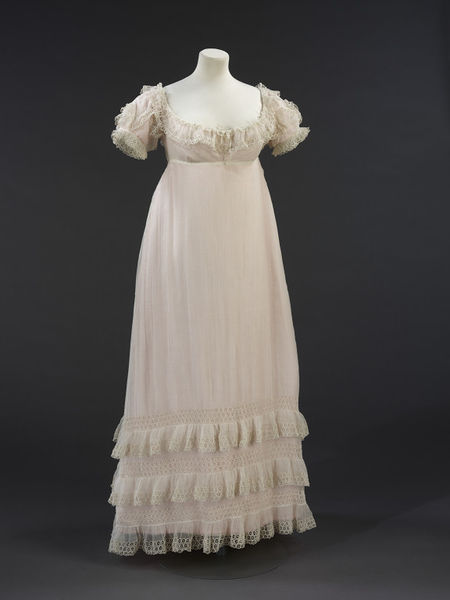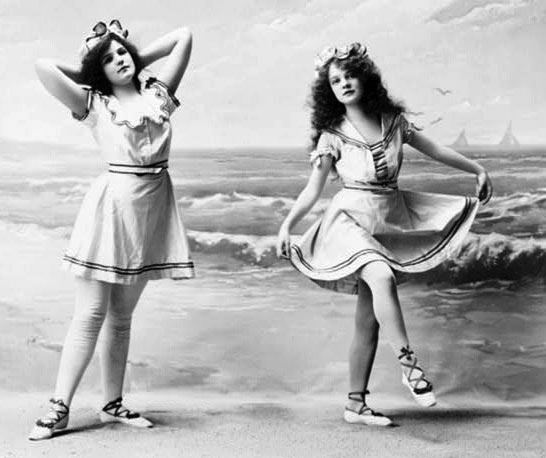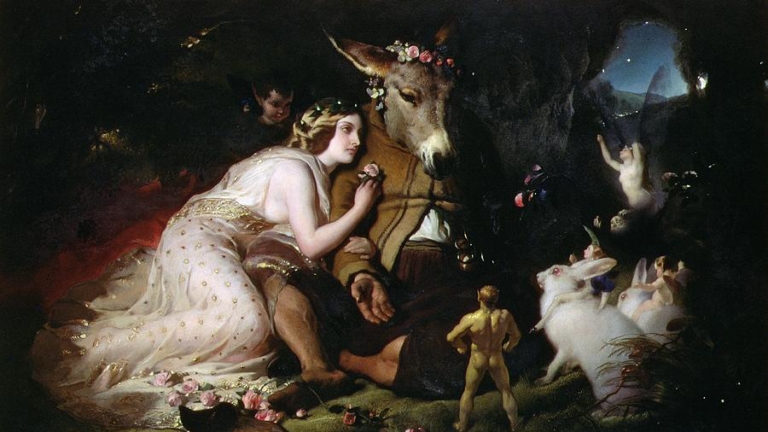Let Them Wear Muslin!

by Feather Tippets-Rosica. Originally published in the May / June, 2009 issue of Finery

The transition from the elaborate gowns of the eighteenth century, worn over rigidly boned stays and hooped petticoats, to the soft muslin gowns associated with the heroines of Jane Austen’s novels was not a sudden event sparked by the French Revolution. Marie Antoinette started it well before that. By the time the painter Elisabeth Vigée le Brun scandalized the masses by exhibiting the Queen in what appeared to be her underwear in 1783, the Queen and her maids of honor had be dressing en chemise for several years and not just in the privacy of their boudoirs.
Le Brun was forced to remove her painting from the public eye, but like all scandals, it inspired more than deterred, and the chemise gown became the symbolic frock of the 1780’s. In 1784, Georgiana, Duchess of Devonshire, noted in her diary that she attended a concert in a muslin chemise with fine lace given to her by the Queen of France.
The earliest versions were formed like actual chemises, worn belted with broad silk sashes tied in back. Full sleeves were accompanied by a ruffled collar neckline. As the style progressed, a gathering line below the bustline but above the waist was added, beginning the upwards climb of the line between bodice and skirt. By 1790 classical lines and revolutionary ardor had taken the beau monde by storm. Fashionable women appeared in portraits and the salons as idealized Roman matrons or Greek goddesses. This effect was primarily achieved by losing the gathering at the natural waistline and the fullness of the sleeves. Sleeves were either close fitted into the armhole, usually ending just above the elbow, or non-existent, a la toga.
As revolutionary sentiment reached a fever pitch, spurred on by the writings of Voltaire and Rousseau, the pinnacle of outward expression of revolutionary fervor was the Roman simplicity and egalitarian nature of the white muslin gown. Evidence of social distinction in dress was abolished by the National Assembly. Interest in the archaeological discoveries at Herculaneum and Pompeii stimulated an admiration of ancient civilization and the glories of the Greek and Roman eras. Neoclassicism became the official art of the French empire when Napoleon gained power, and had a major effect on motifs and decoration.
Quite modest by our standards, in 1791 the simple frock was every bit as daring as can be imagined. Worn both with and without stays, the gown’s scandalous effect was often enhanced by dampening the dress with water so it would cling to the figure like a classical statue. When Jerome Bonaparte, brother of Napoleon, married Elizabeth Patterson of Baltimore on December 24, 1803, the beautiful and fashionable American was married in a dress of muslin that “would fit easily into a gentleman’s pocket.”
By 1814 gowns boasted long sleeves, high necks, and a very high waist. The simple classical silhouette began to be replaced by mounds of ruffles and 3-dimensional trims. Ruffles appeared on sleeves, bodices, hems and bonnets. By 1816-1817 the waistline had risen to just under the breasts and could go no higher. There was only one direction that waistlines could go; beginning in 1818, they began to drop by about an inch a year. The curlicues and undulating lines of the aristocratic rococo fabrics were abandoned for the simplicity, straight lines, stripes and motifs of classical antiquity. Stiff silks and brocades gave way to soft cottons and pale colors, with classic white in great favor. At first, embroideries on hems and borders were influenced by classical Greek patterns, but after Napoleon’s triumphant return from Egypt in 1804, decorative patterns began to reflect an Eastern and Egyptian influence as well.
Buckles and heels on shoes were abandoned in favor of laces and flat slippers emulating Grecian sandals. Thomas Jefferson shocked the American public at his inauguration as our 3rd president in 1801 when he appeared in shoes with laces rather than buckles, showing his sympathy for French Republican ideals. Buckles in France had come to be viewed as a symbol of aristocracy, while lace-up shoes reflected the dress of the ancient Greeks and Romans.
In the beginning throes of the French Revolution, lace was a symbol of the aristocracy and many lace-makers were murdered and their patterns destroyed. As Napoleon gained power, his interest in the building the French economy reestablished the industry and brought lace back into favor. Lace was again used as a trimming and lace veils were seen draped over the front edges of bonnets.
Bonnets of various shapes and sizes appeared, made of gauze, straw, satin, velvet and fur. Turbans were in style after Napoleon’s Egyptian campaign, made of brocade, satin, and striped sheer gauze, trimmed with aigrette and feathers.
Since the lines of the gowns could not allow for pockets, small bags or reticules were carried. Beginning as small crocheted bags, they soon are made from fabric or leather with embroidered or painted motifs. Fans were sized smaller to fit neatly into the new reticules.
Bracelets, necklaces, rings of ancient Greek and Roman style were popular and cameo jewelry was highly prized.
But the accessory of most prominence in this period and which would continue to be worn for another 100 years was the shawl. Woven of fine cashmere with embroidered borders, it dated from the return of Napoleon’s armies from Egypt. Upon Josephine’s death it was discovered that she owned over three hundred shawls, costing anywhere from 15 to 20 thousand francs each.


Leave a comment